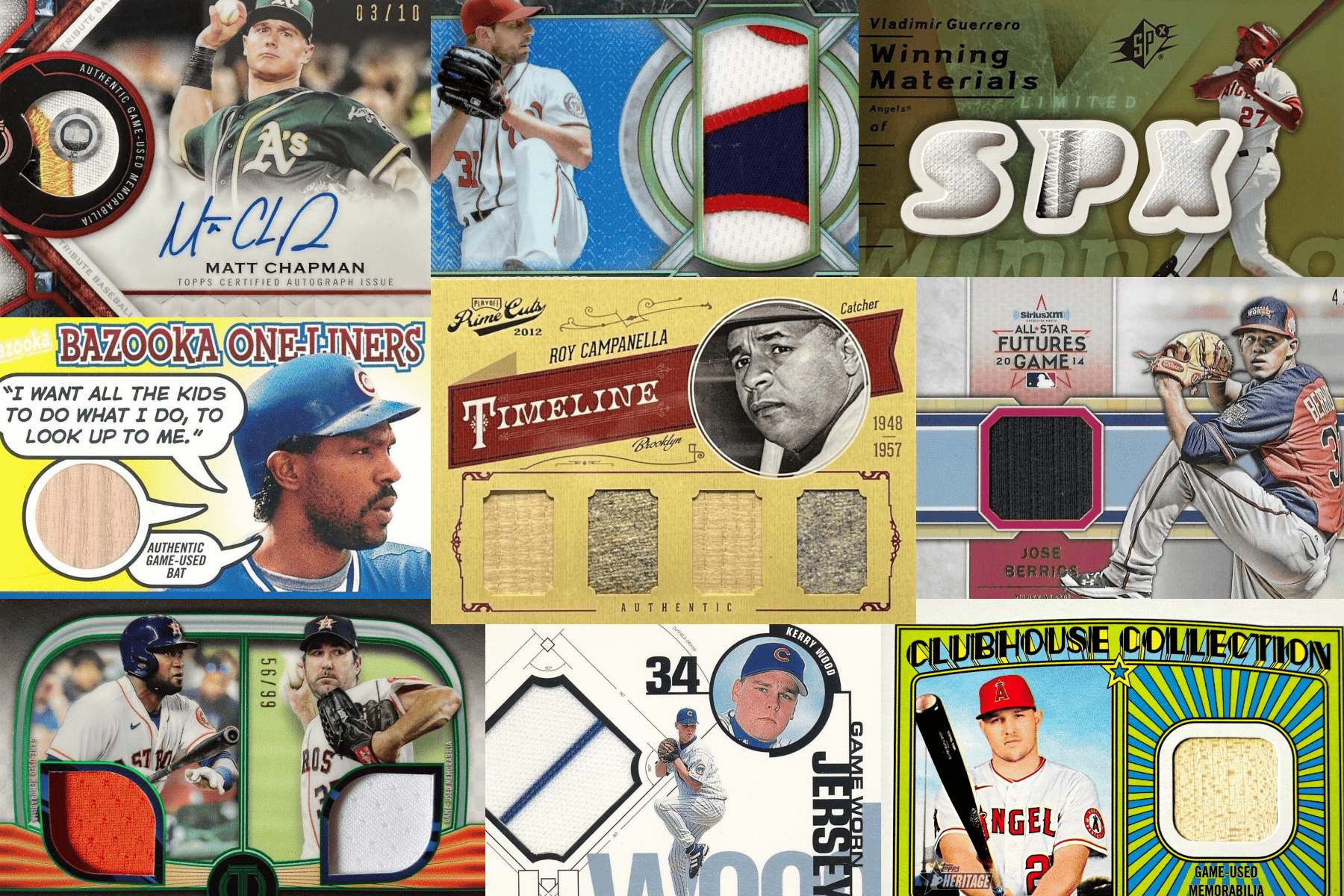Relic cards have become a staple of the modern baseball card hobby. They offer collectors a tangible connection to the game through embedded pieces of jerseys, bats, and other memorabilia. These cards first gained widespread popularity in the late 1990s, when card manufacturers sought to innovate beyond traditional inserts. Today, relic cards can feature everything from game-used bats and jerseys to stadium seat fragments and dirt from the field. While these additions make for visually striking collectibles, they also introduce questions about authenticity, terminology, and how materials are sourced.
Ensuring that relics are genuinely game-used has been a topic of debate among collectors. Card manufacturers use various classifications, such as “player-worn,” “event-used,” and “game-used,” but these terms don’t always mean the same thing. The process of authentication varies by company. This article will examine how manufacturers authenticate relic materials, the terminology they use, and what collectors should know when evaluating what makes relic cards real.
What is a Relic Card?

The term “relic” is a hobby-specific adaptation of the broader meaning. It is something preserved from the past or of notable significance. In card collecting, “relic” became popular shorthand for any card featuring an embedded piece of memorabilia, regardless of its age or rarity. It’s more accurate than using terms like “game-used” since, as we’ll see later, is more specific.
There are subtypes of relics, such as the “patch card,” when the relic is a piece of fabric that shows multiple colors or stitching. Some cards even specify the exact material – “bat knob” or “jersey card” as a way to highlight uniqueness and enhance desirability. Over time, the word “relic” has become deeply ingrained in the hobby’s terminology, signaling that the card offers more than just a printed image – it holds an actual piece of the sport.
Relic Card Terminology
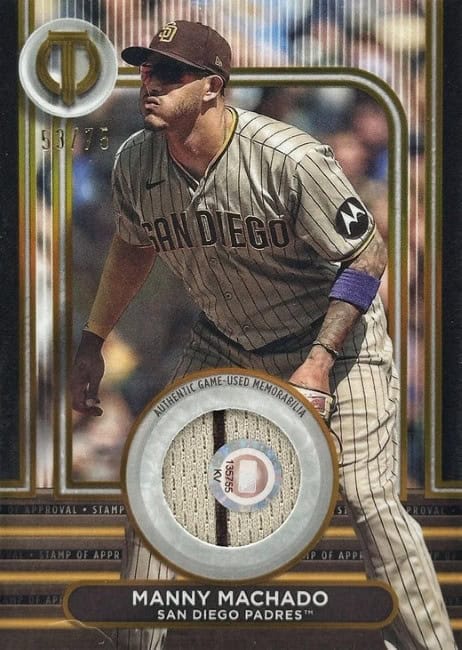
Understanding the terminology used on relic cards is essential for collectors who want to make informed purchases, or those who seek to understand what they’ve just pulled from a pack. Manufacturers use a variety of phrases to describe how a relic was obtained and whether it is game-used. However, these terms are not always consistent across brands. Below is a list of common relic card terms and what they signify. This will help collectors better evaluate the authenticity and significance of the memorabilia embedded in their cards.
Game-Worn/Game-Used
This is the gold standard term in relic cards, but they can mean slightly different things. “Game worn” means that the player wore the item during a game. The key here is “worn” – they might have sat on the bench or in the bullpen, but they were wearing it. “Game-used,” on the other hand, means they were in the game. It might contain dirt or grass stains, which is a nice bonus.
If game-used is the gold standard, a card that lists a specific game is the platinum level. Topps Tribute Stamp of Approval, for example, uses MLB Authentication services. They identify, through a hologram sticker, the specific game where a piece of jersey was used. Fans can then look up that game and see how the player performed.
For next-level collectors, Topps has started a new tradition. They now produce 1/1 debut patch cards, which feature the patch worn on a player’s jersey in their first game. These are extremely rare, and Paul Skenes’s debut patch card sold for $1.11 million.
Player-Worn/Player-Used
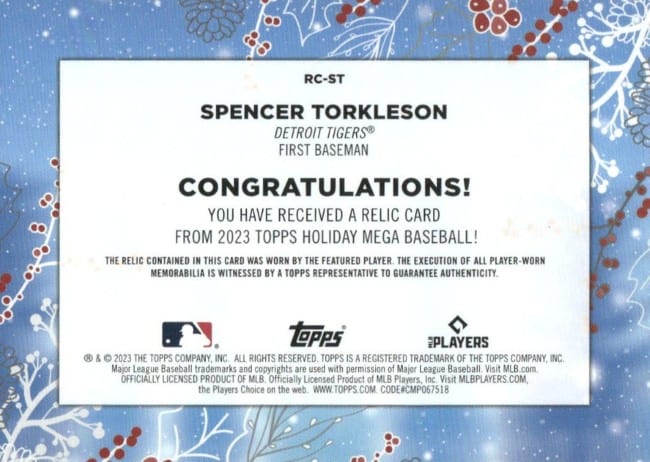
These terms indicate that the relic was used by a specific player, but not necessarily during an official game. This could include items used during practice, promotional events, or other non-game settings.
As with game-used items, the terms “worn” and “used” mean different things. As popular Internet cynics will tell you, “player-worn” may mean that a player put a jersey on and then immediately removed it without stepping foot near a stadium. Although that’s the cynical view, there’s a “buyer beware” message in there too – “Player-worn” or “player-used” promises no more, and no less, than what it says.
Event-Worn/Event-Used
This term is similar to game worn, but can be used for events that are not part of the regular season. For example, at the All-Star Game, a jersey may be worn during a workout day, or to take a team photo.
Not from Any Specific Game
This is the most common disclaimer. It scares away many fans, but it shouldn’t. It’s used when the company can verify that the item was used by the player, but cannot verify in what game it was used.
This is the most common term on relic cards. It does not mean an item is not authentic – it simply means it was not tracked from the time it was on the player’s back to when it was inserted in the card. Tracking the specific game is a new concept, so “Not from Any Specific Game” might get phased out as the MLB Authentics technology develops.
Commemorative Patch

Although we’re generally a relic-positive bunch here, one of the more misleading “relics” starting to flood the market are commemorative relics. These are patches produced for the sole purpose of putting them into a card. They are never worn by a player or attached to official equipment in any way. For example, the 2023 Topps Commemorative Patch cards have the disclaimer: “This commemorative team logo patch relic was specially created for 2023 Topps Baseball Series 1.” Some also say “Commemorative manufactured patch.”
They commemorate events like these:
- Father’s Day
- All-Star Game
- Spring Training
- Jackie Robinson Day
- Silver Slugger
- Topps 70th Anniversary (2021 Topps)
- 150th Anniversary of Professional Baseball (2019 Topps)
- Yankee Stadium Inaugural Season (2010 Topps)
These commemorative-type cards can also include stamps and coins integrated into the design. In most cases, they’re easy to spot if you’re looking for the disclaimer.
Other Considerations
These terms primarily apply to jerseys, which are the most common type of relic. Similar wording is used for other clothing items like socks and pants. However, relics extend beyond fabric. Bat relics, for instance, may be labeled “game-used” or “player-used,” but never “game-worn” for obvious reasons. Memorabilia such as bases are almost always categorized as game-used. However, it’s always wise to check the back of the card for confirmation.
Vintage Relic Cards
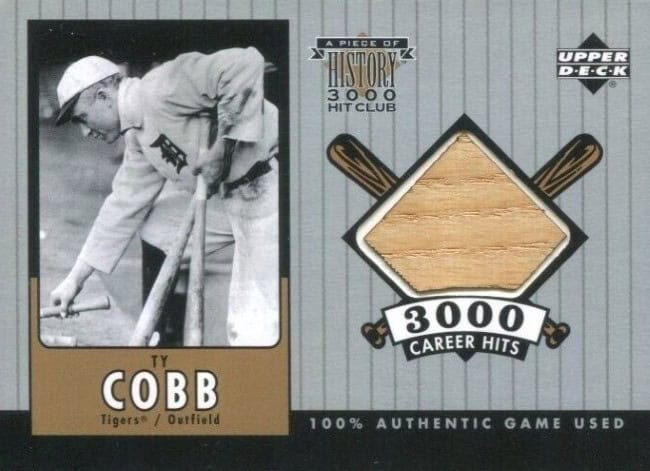
Authenticating vintage relics is a more complex process than with modern memorabilia. The materials often come from decades-old sources with limited documentation. Unlike contemporary jerseys and bats, which can often be traced directly to MLB teams or manufacturers, vintage relics may originate from private collections, auction houses, or team archives. To verify authenticity, manufacturers and third-party authenticators rely on:
- Provenance records
- Photo-matching techniques
- Forensic analysis of materials such as fabric weave patterns, stitching, and wood grain
In some cases, relics are sourced from museum-quality collections or high-profile auctions where the item’s history has already been well-documented.
Because of the challenges involved in sourcing and verifying vintage relics, companies are often cautious with their labeling. A bat relic from a Hall of Fame player, for instance, may be described as “game-used” only if it has been confirmed through previous authentication. Otherwise, it might simply be labeled as “player-used” or “bat piece,” leaving room for ambiguity. Jerseys present similar challenges, as older materials may have deteriorated over time, making verification more difficult. Collectors interested in vintage relics should pay close attention to the authentication process used by the card manufacturer, as well as any third-party verification that accompanies the card, to ensure they are acquiring a legitimate piece of baseball history.
Should You Trust Relic Cards?
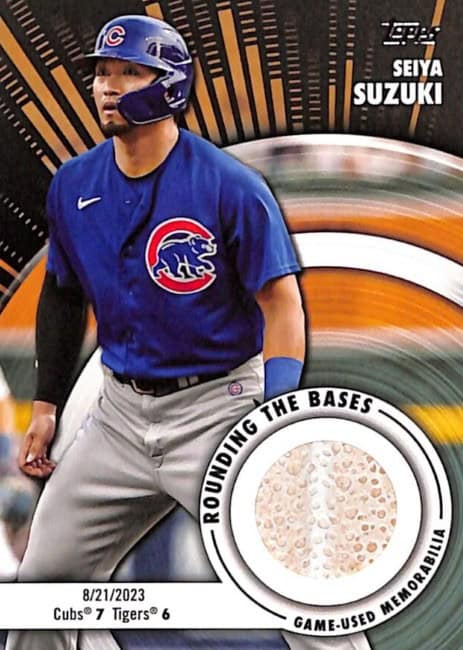
Whether you should trust relic cards largely depends on the reputation of the manufacturer and how transparent they are about their authentication process. Established companies like Topps, Panini, and Upper Deck have varying standards for relic verification, and the wording on card backs can provide clues about a relic’s authenticity. Terms like “game-used” imply a higher level of confidence.
One thing to keep in mind – especially for cautious collectors – is that card companies will use the most accurate disclaimer they can verify. It doesn’t mean they’re not real; it just means they’re being cautious.
Collectors should always research before purchasing high-value cards, including relics. Reading manufacturer disclosures, investigating past controversies, and consulting reputable hobby sources can help determine whether a particular card is worth trusting. If a relic card lacks specific details about its origin or comes from a manufacturer with a history of vague or misleading claims, it’s wise to proceed with caution. While some relics are unquestionably legitimate, not all are created equal – due diligence is key to making informed purchases.
Criticisms of Relic Cards

Not all collectors are enthusiastic about relic cards, and some are outright critical of their existence. Detractors argue that cutting up game-used memorabilia diminishes its historical value, reducing jerseys and bats to small, often indistinguishable fragments. Others are skeptical of the authenticity claims made by card manufacturers, believing that vague or misleading wording – such as “player-worn” rather than “game-used” – undermines the legitimacy of these cards.
The debate can sometimes become heated within collecting communities. Some traditionalists see relic cards as gimmicky, dismissing them in favor of vintage cardboard or autographs. In extreme cases, discussions about relic cards can turn into arguments, with critics being dismissive or even rude toward collectors who enjoy them. However, as with any aspect of the hobby, personal preference plays a major role, and those who appreciate relic cards often find value in the tangible connection they provide to the game and its players.
Conclusion

Understanding relic card terminology is crucial for collectors who want to make informed decisions about their purchases. Terms like “game-used,” “player-worn,” and “event-used” may seem similar, but they carry different implications about how the memorabilia was obtained and whether it has a direct connection to actual gameplay. Since manufacturers are not always transparent in their descriptions, knowing these distinctions helps collectors gauge the true significance of a relic card.
At the same time, skepticism is warranted when dealing with relics. The authentication process varies by company, and vague disclaimers can sometimes obscure the true origin of the memorabilia. This is why researching the manufacturer’s reputation, reading card backs carefully, and staying informed through collector communities is essential.
Ultimately, relic cards can be a fascinating part of the hobby, offering collectors a tangible piece of baseball history. However, not all relics are created equal, and understanding the terminology used to describe them is the best way to separate truly valuable pieces from those that are less trustworthy. By staying educated and approaching relic cards with a critical eye, collectors can better navigate this segment of the market and make smarter, more satisfying additions to their collections.
